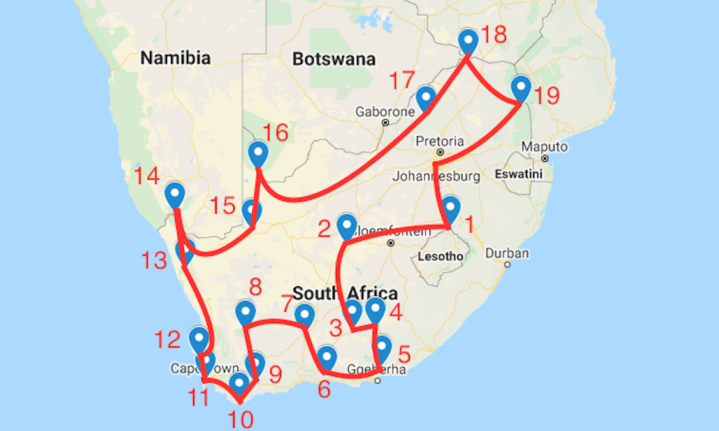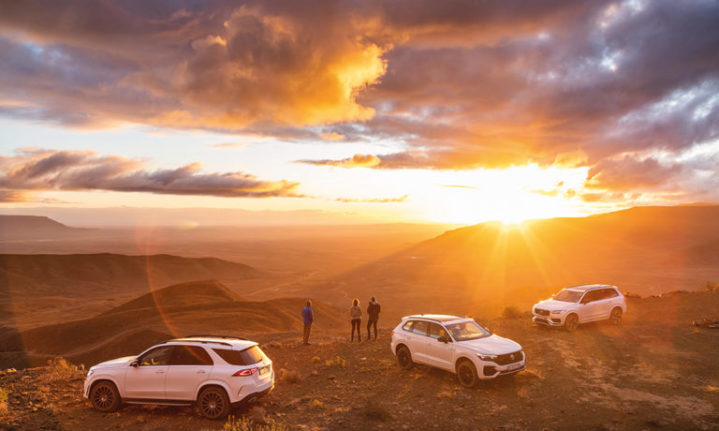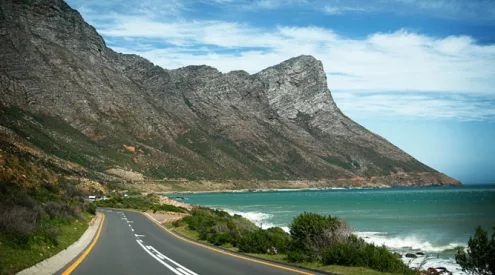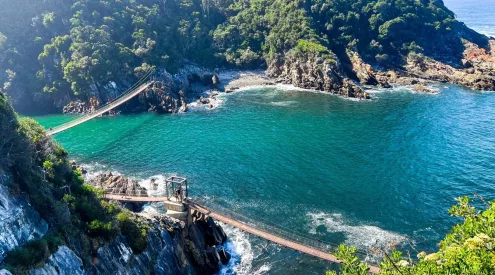Some people invest in unit trusts, others in property, but not all pension plans look the same and since putting this list together, my one now involves a countrywide road trip to visit all of our 19 national parks. Six weeks seems like a good amount of time to devote to it.
This isn’t the first time someone has thought to put together a road trip like this. In the United States, it’s a fairly common pursuit for those who love nature, are adventurous and can tolerate long drives.
Scott Ramsay spent three years visiting South Africa’s wild places between 2011 and 2013. On his journey, which was supported by South African National Parks, he visited more than 50 protected areas in South Africa, including all 19 national parks. A regular contributor to our print magazine, Scott has carved a life out of documenting such places and has now photographed more than 100 protected areas and conservancies in 12 African countries.
This proposed road trip, starting and ending in Johannesburg, clocks in at 7260 km.
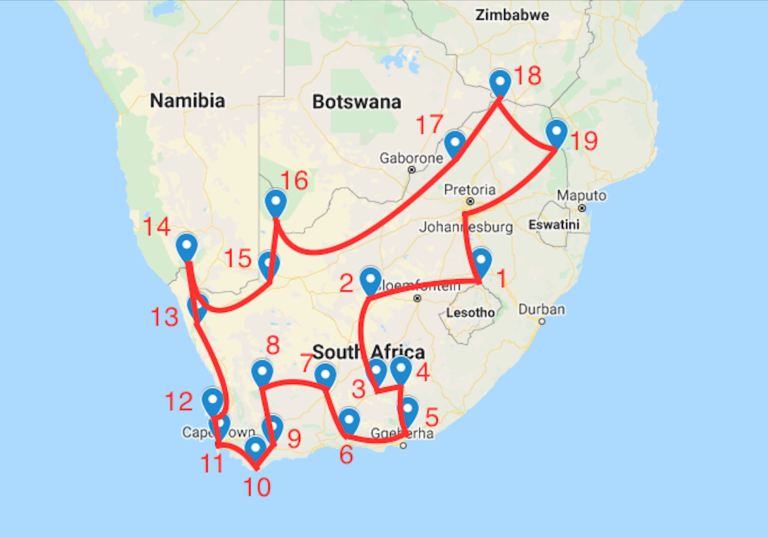
Nothing quite excites like the promise of an unusual road trip map.
You may want to slice up the route slightly differently between the Garden Route and the Karoo, but I suppose that’s the joy of a road trip – the freedom to be the master of your own journey. Interestingly, KZN doesn’t appear on the list. (Royal Natal National Park, despite its name, is in fact not a national park.)
The trip, in this order, would visit the following parks:
1. Golden Gate Highlands National Park
Start your trip off with a gilded bang as you explore the rolling foothills of the Maluti Mountains in north eastern Free State. The park derives its name from the brilliant shades of gold cast by the sun on the park’s sandstone cliffs. Stand the chance to see black wildebeest, eland, oribi, zebra, the rare bearded vulture (lammergeier) and the equally rare bald ibis, which breed on the ledges in the sandstone cliffs.
2. Mokala National Park
Established in 2007, Mokala is one of the country’s newest parks and situated in the far eastern corner of the Northern Cape. Mokala is a Setswana name for camel thorn, which is an incredible resource to the wildlife that survives in often harsh conditions characteristic of this area. Many animals have been relocated to the park and include black and white rhino, tsessebe, roan antelope, red hartebeest, buffalo, gemsbok and black wildebeest.
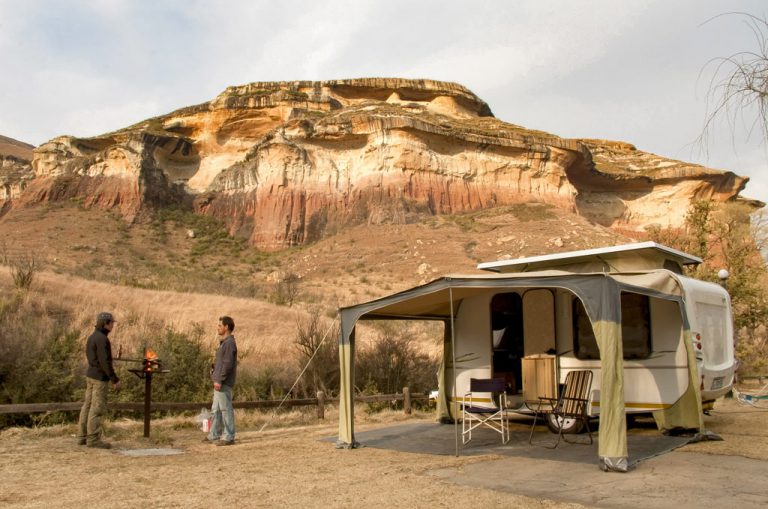
Glen Reenen Rest Camp, Golden Gate National Park.
3. Camdeboo National Park
You’ve now entered the Karoo, a place that has a soft spot in many South African’s hearts. Camdeboo National Park provides a fascinating insight into the unique landscape and ecosystem, not to mention awesome scenic beauty. And if you want a taste of the local people, head into the historic town of Graaff-Reinet. Or, probably an even better idea, visit the nearby Valley of Desolation.
4. Mountain Zebra National Park
Next, head east towards Cradock to discover the conservation success story of a park that saved the Mountain Zebra species from extinction. In 1937, when the park opened it had only six zebra on 1 712 hectares of land. These zebra didn’t survive but donations by local farmers ensured the species and the park continued. Today it boasts 370 zebra roaming in 28 412ha, kept company by black rhino, eland, black wildebeest, red hartebeest and Cape buffalo.
5. Addo National Park
Time to take things up a level – all the way up – for a rendezvous with the world’s largest animal. Originally proclaimed in 1931 with only 11 elephants, today this finely tuned ecosystem is a sanctuary to over 450 of the animals – the densest elephant population on earth. The iconic black-maned lions of the Kalahari were introduced to Addo over 15 years ago. The big reason for choosing these lions (as opposed to somewhere like Kruger) is because they are disease-free and would not affect the buffalo population, which might have otherwise caught tuberculosis.
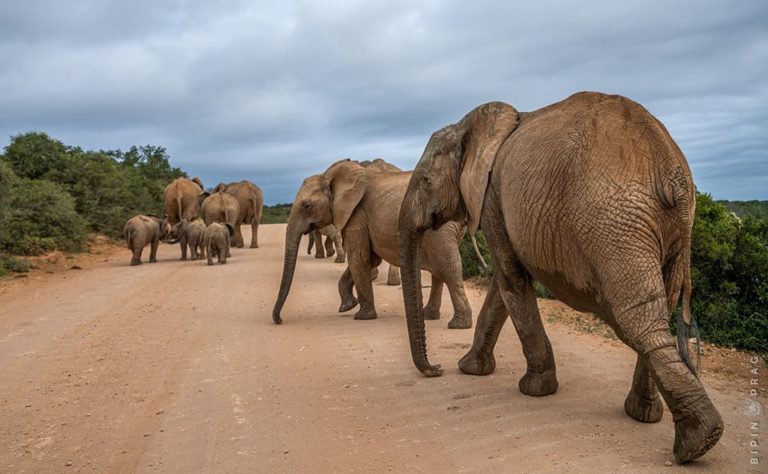
An ellie roadblock in Addo Elephant National Park.
6. Garden Route National Park
You’ve now made it all the way to the lush slopes of the Garden Route and its national park where you can explore the beautiful beaches, rugged coastlines, indigenous forests and much more. Guides here can take you on an epic journey by foot, kayak, lilo, boat, mountain bike, scooter and Segway. And, if you’re lucky, you might even slip in a trip on the Otter Trail.
7. Karoo National Park
After submerging in the waters of the Garden Route, track back inland. We recommend taking the Swartberg Pass, one of the iconic roads in SA. The Karoo National Park is dominated by the lofty Nuweveld Mountains and rolling plains, with a unique variety of wildlife that may require some patience to spot. Interestingly, the park has five species of tortoise, the highest density of species per equivalent area anywhere in the world. Over 20 breeding pairs of black eagle find sanctuary within the park. But keep in mind that a park such as this is as much about the landscape and succulents as the wildlife.
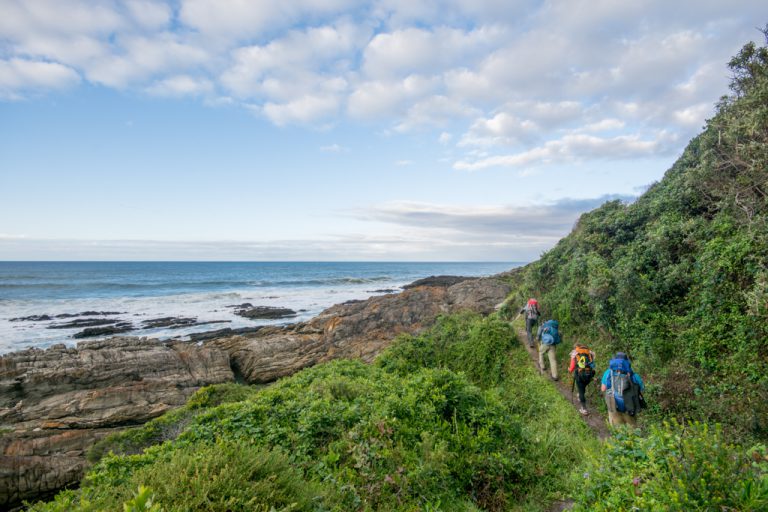
There are many log stairs but there’s always something beautiful to look at from the top on the Otter Trail in the Garden Route National Park.
8. Tankwa Karoo National Park
Things are about to get even dustier and sparser in the Tankwa Karoo, home to epic sunsets and the occasional hedonistic jol for art lovers. This 80 000-hectare park is worth visiting for its koppie-studded, moon-like landscape, diversity of succulent plants and fine Karoo birding. Only two southern African regions have been designated as Biodiversity Hotspots by Conservation International. One is the Cape Floral Kingdom, and the other the Succulent Karoo, of which Tankwa is part. There are tourism facilities, accommodation and camping within the park and a couple of privately operated B&Bs on the periphery.
9. Bontebok National Park
We’re bouncing back towards the coast as we head towards Swellendam. A detour via Tradouw Pass is recommended for the curious and adventurous. Set against the majestic Langeberg Mountains, the park boasts proud achievements in biodiversity conservation, from the endangered fynbos veld type, coastal renosterveld, to the namesake bontebok. Once these colourful antelope numbered a mere 17, now the population sits at around 3 000. The park also offers bird watchers over 200 bird species.
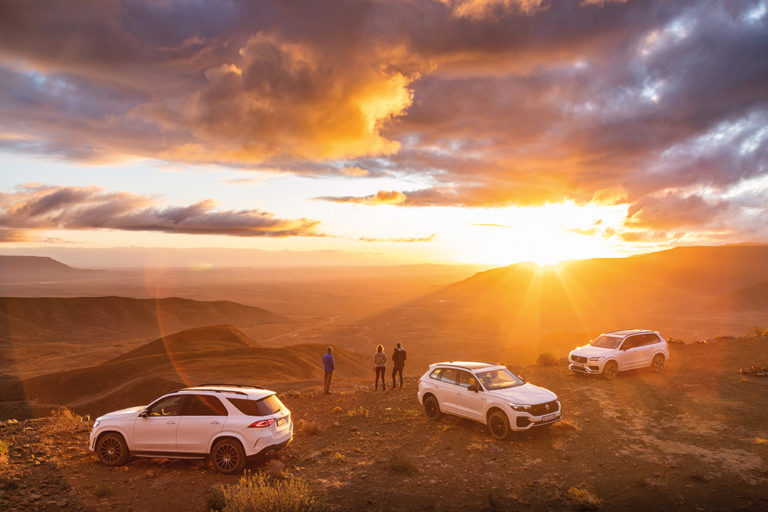
The Tankwa Karoo transforms at sunset.
10. Agulhas National Park
Just 100 kilometres southwards lies the Agulhas National Park. What goes on here? Well, you can stand at the southernmost tip of Africa, where two oceans meet. Explore the historic Cape Agulhas lighthouse. Marvel at the shipwrecks that dot this rugged, beautiful coastline. Curl up in front of a cosy fire with the sound of the crashing waves in the background. Or, my personal favourite, just kick back and watch the ocean as a fire sizzles next to you.
11. Table Mountain National Park
Congratulations, you’ve reached the halfway stage of the road trip, more or less. Don’t get distracted by the beaches, wine farms or restaurants please – let’s stick to the script. We have nature to explore. A visit to the penguins at Boulders Beach is part of the itinerary, as is a walk on Cape Point. Ultimately though, we’re here to scale a mountain. My recommendation is Indian Venster but if you prefer another route, or even the cable car, I’m not here to judge. Stand atop Table Mountain and cast your gaze northwards to where you’ve come. Take a deep breath and continue on, we have further to go.
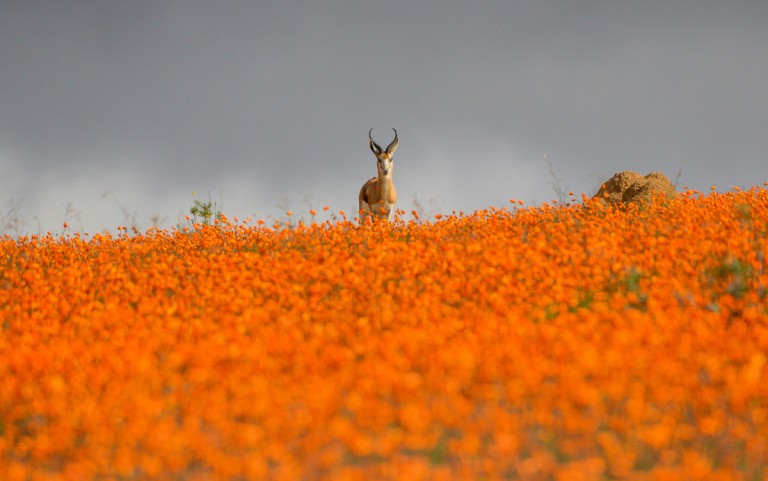
A springbok ram stands watch amid a huge carpet of Namaqua daisies as a storm rolls across the Namaqualand. Credit: Cathy Withers-Clarke
12. West Coast National Park
In an ideal world, you’d visit this park in August or September when the daisies are exhibiting their carnival of kaleidoscopic colours. But even if you are here another time, there’s still much to enjoy. The Langebaan Lagoon is the focal point of this small park, which has seaside braai areas and picnic spots to enjoy the views.
13. Namaqua National Park
Similarly to the West Coast National Park, a tapestry of brilliant colours unfolds enticingly along the winding roads of Namaqua in August and September. Butterflies, birds and long-tongued flies dart around among the flowers, seemingly overwhelmed by the abundance and diversity. Here’s a fact for you – with its winter rainfall, Namaqualand is home to the richest bulb flora of any arid region in the world and more than 1 000 of its estimated 3 500 plant species are found nowhere else on earth. Fields of flowers, star-studded nights, quiver trees, enormous granite outcrops and the icy Atlantic are just some of the sights to catch.
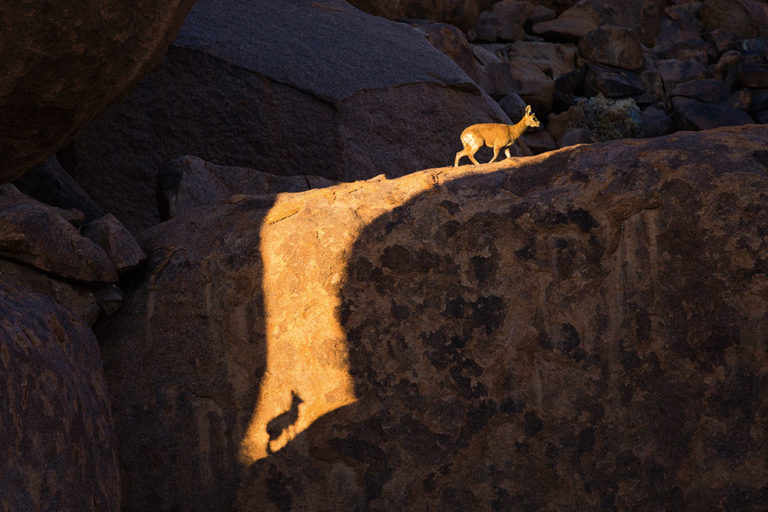
The koppies at Kokerboomkloof in the Richtersveld National Park are home to klipspringer. Credit: Basson van Zyl
14. |Ai-|Ais / Richtersveld Transfrontier National Park
Things are getting even more remote and adventurous in this park, which is only accessible by 4×4 vehicles or vehicles with high clearances and is managed jointly by the local Nama people and the South African National Parks. A desolate and forbidding landscape belies the fact that the Richtersveld has the world’s richest desert flora. Miniature rock gardens, perfectly designed by nature, cling precariously to cliff faces. Tiny succulents, mere pinpoints against a backdrop of surreal rock formations, revel in the moisture brought by the early morning fog rolling in from the cold Atlantic Ocean.
15. Augrabies National Park
Few sights are as awesome or a sound as deafening as water thundering down the 56m Augrabies waterfall when the Orange River is in full flood, as it recently was. The Khoi people called it “Aukoerebis”, or place of Great Noise, as this powerful flow of water is unleashed from rocky surroundings characterised by the 18km abyss of the Orange River gorge in the far Northern Cape. The 55 383ha on both the northern and southern sides of the Orange River provide sanctuary to a diversity of species, from the smallest succulents, birds and reptiles to springbok, gemsbok and giraffe.
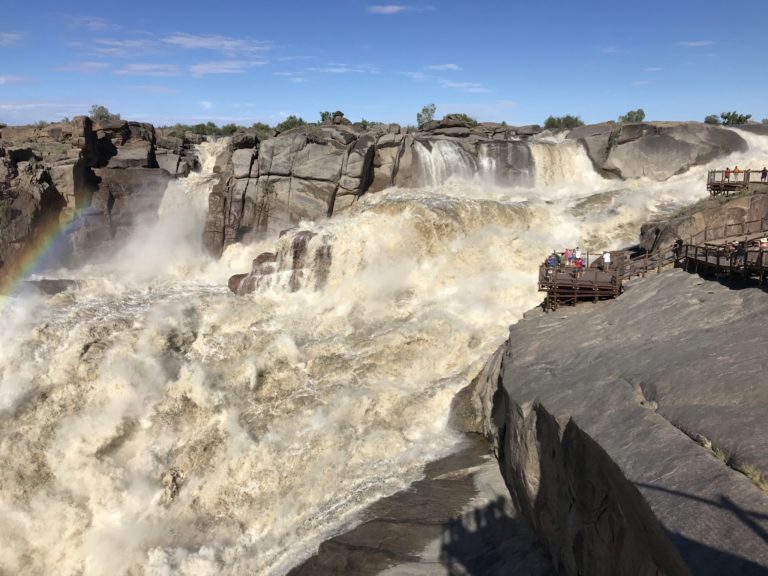
Augrabies Falls, gooi pappie! Picture © Cristine Wekenborg
16. Kgalagadi Transfrontier Park
The Kalahari Gemsbok National Park in the far Northern Cape was proclaimed in 1931 to protect migrating game, especially the gemsbok. Together with the adjacent Gemsbok National Park in Botswana, this park comprises an area of over 3.6-million hectares, which is, to use a local term, moerse big. It’s nearly twice the size of the Kruger National Park, and was the first Transfrontier Park to be established in Africa. Kgalagadi is the first park to provide accommodation in three wilderness camps that, with no fences, invite the Kalahari and the tranquillity of Africa right into your room, welcome or not.
17. Marekele National Park
OK, we’re drawing closer to home now as we sweep into the Waterberg region in Limpopo. As its Tswana name suggests, this place has become a “place of sanctuary” for an impressive variety of wildlife due to its location in the transitional zone between the dry western and moister eastern regions of South Africa. Contrasting majestic mountain landscapes, grass-clad hills and deep valleys characterise the park. All the large game species from elephant and rhino to the big cats as well as an amazing variety of birds including what’s probably the largest colony of endangered Cape vultures (more than 800 breeding pairs) in the world, have settled here.
Speaking of Limpopo, this is a region that has plenty to offer. Why not check out this list of the ultimate things to do in Limpopo?
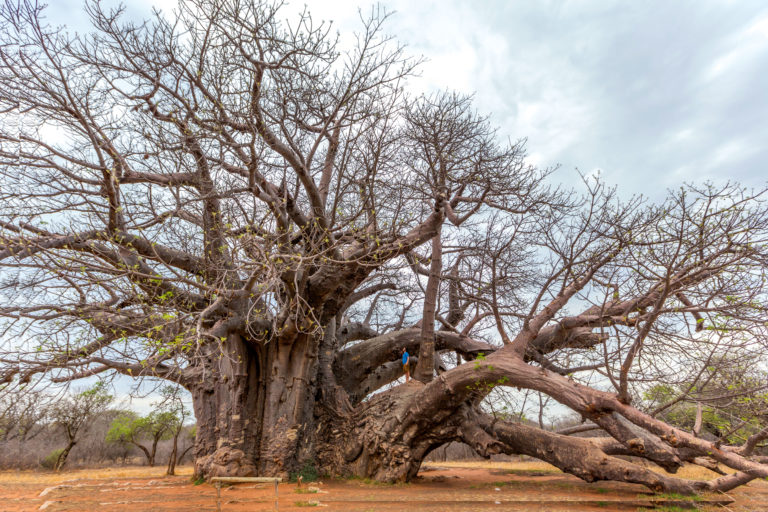
Sagole Baobab in Limpopo is the biggest of its kind in the world and is estimated to be around 1 200 years old. Visit it on your route between Mapungubwe and Kruger.
18. Mapungubwe National Park
Our second-last park has the most cultural importance, due to the archaeological treasures of Mapungubwe. The park is the site where a developed African civilisation prospered between 1000 and 1290 AD. The area was already inhabited by a growing Iron Age community from 900 AD and became rich through trade with faraway places like Egypt, India and China. From a hilltop on the northern edge of the park the visitor can view the confluence of the legendary Limpopo and Shashe Rivers, as well as two neighbouring countries: Botswana and Zimbabwe. Elephant, giraffe, white rhino, eland, gemsbok and numerous other antelope species occur naturally in the area. Predators include lions, leopards and hyenas.
19. Kruger National Park
As you may have observed, we have saved the best for last. One could spend six weeks only exploring Kruger and you’d probably still feel like there’s more to see. Established in 1898 to protect the wildlife of the Lowveld, this national park of nearly 2 million hectares is unrivalled in the diversity of its life forms and a world leader in advanced environmental management techniques and policies. Truly the flagship of the South African national parks, Kruger is home to an impressive number of species: 336 trees, 49 fish, 34 amphibians, 114 reptiles, 507 birds and 147 mammals. The park has 13 rest camps, 11 bushveld camps, and 11 lodges.
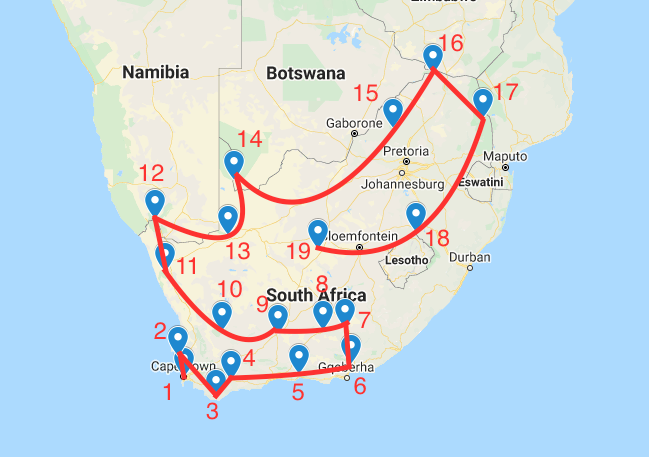
Follow this route if you want to start in Cape Town.










